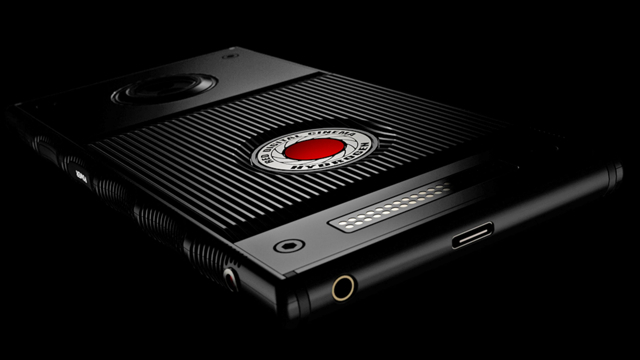RED, the company known for its 4K Epic and Weapon film/TV cameras, just debuted a smartphone, the RED Hydrogen One, which will be offered by AT&T and Verizon. The Android phone, which has a 5.7-inch display, is, says the company, “the foundation of a future multi-dimensional media system.” The phone can connect to RED’s other cameras via pogo pins and, in the future, to lens mounts and other modules. RED’s first such module will be a DSLR-similar camera sensor. The phone also produces holographic images.
The Verge reports that, according to chief executive Jim Jannard, “the company wants any traditional big camera lens to be attached to it,” including those from Fuji, Canon, Nikon, Leica and others. As might be expected from a smartphone that aims to be part of a “media system,” the Hydrogen One is “very big” — larger than an iPhone 8 Plus, “complete with a USB-C plug, stereo speakers, and a headphone jack.”
Similar to RED’s other industrial-looking products, the Hydrogen RED comes in aluminum (at $1,195) or titanium (at $1,595).
The phone’s other innovation is what RED calls “4-view,” essentially the ability to “switch the 2,560 x 1,440 screen from a standard 2D to 3D,” which RED calls its “holographic” view. The Verge reviewer called it “a big step over 3D on other phones,” with better 3D depth than he saw on previous phones. The technology behind it is “more than just combining two images to make standard 3D.”
As a phone, he concluded, “most people will be better served by getting something cheaper,” although “as a hologram making and viewing machine, it’s a solid technical improvement over what I’ve seen before.” What remains to be seen is “whether anybody really needs or wants that on a phone.”
VentureBeat reports that, to manufacture its holographic display, “RED partnered with Leia which creates lightfield displays for mobile devices.”
“Leia makes a clear substrate that goes underneath the LCD display with nanotechnology and what happens is if you aren’t watching 4-view content, it’s clear,” said Jannard. “So there’s no hit or consequence to the 2D image, the 2D image is the same resolution, 2,560-by-1,440, it looks sharp, it looks bright, color’s great. When the 4-view turns on, it then redirects light into 4 views — both directions, portrait and landscape — so that the display works in any orientation in 4-view mode.”
Leia is “working on recruiting developers through its Leia Loft department to create games that will leverage its lightfield technology.” According to Leia software engineer Daniel Geisler, the company has developed a Unity plug-in that “enables people to quickly convert their 3D games into holographic ones.” With the plug-in, developers can “adjust the depth of field by attaching a script to a game’s camera.”
They can manually adjust the level of 3D, “but the plug-in will also automatically create a depth of field that Leia has deemed to be the most comfortable for the largest number of players.” Developers can also provide a slider so that players can adjust the 3D settings themselves.
Related:
RED’s New 8K 3D Camera Uses Hydrogen One Phone as Viewfinder, CNET, 5/22/18
RED Is Partnering With Lucid to Build an 8K 3D Camera for the Hydrogen One Phone, The Verge, 5/22/18


No Comments Yet
You can be the first to comment!
Sorry, comments for this entry are closed at this time.